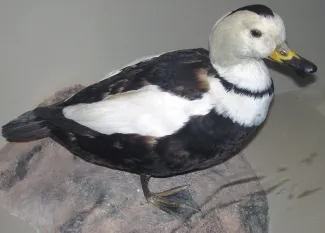
In a world where the threat of extinction looms large, the tragic history of the Labrador Duck, Camptorhynchus labradorius, serves as a stark reminder of the devastating impact of human activities on our vulnerable ecosystems. This magnificent bird, once native to North America, is now completely extinct due to overhunting and habitat disturbance.
The Labrador Duck, known for its striking black plumage and unique bill structure, was adapted to life in rugged coastal environments. With a large, broad bill adorned with hooks on both the upper and lower mandibles, this duck was capable of scraping shellfish and other seabed organisms from rocks and kelp. It was an impressive adaptation that testified to the wondrous diversity of nature.
Sadly, the Labrador Duck couldn't withstand the consequences of human greed. The bird was intensively hunted for its meat and feathers, causing its populations to plummet. Both Inuit communities and European settlers relied on this duck as a source of food. Eggs were collected for consumption, leaving little chance for reproduction and population recovery.
Furthermore, the rise of commercial fishing had a devastating impact on the habitat of the Labrador Duck. Fishing activities disrupted the food chain, diminishing the available food sources for the duck. The combination of overhunting and loss of food resources made it impossible for the Labrador Duck to survive.
The sobering truth is that the last sighting of a Labrador Duck dates back to 1878, on Elm Island in the Labrador region of Canada. Since then, this majestic bird has vanished forever. The extinction of the Labrador Duck serves as a poignant reminder of the importance of protecting endangered species and preserving their habitats.
Scientists have learned from this tragic history and now recognize more than ever the need to take proactive action in biodiversity conservation. The loss of a single species can have a domino effect on entire ecosystems, ultimately affecting our own health and well-being.
As we become aware of the devastating effects of human activities on nature, we must take steps to break these harmful patterns. Conserving endangered species and their habitats, addressing overhunting, and promoting sustainable practices are crucial measures we must undertake to safeguard our biodiversity.
Let us seize the sorrowful tale of the Labrador Duck as an opportunity for change. Let us embrace our responsibility to preserve the wondrous diversity of life on Earth, so that future generations can revel in the unspoiled beauty of nature and the precious species it holds.